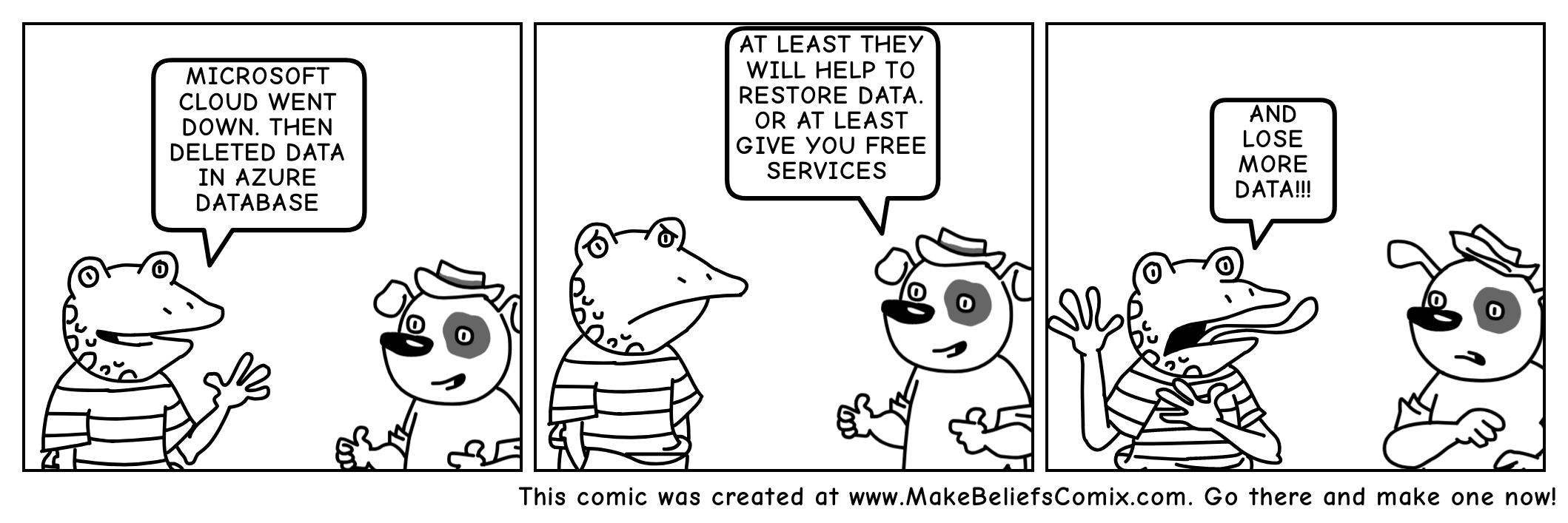azure down

Databases losing data is bad. Not once but repeatedly.
Azure has come a long way since its rough beginnings. It was frankly unusable in its early days. To its credit, Microsoft has embraced much of the Open Source innovations and adopted aggressive improvements in Azure architecture and things have gotten much better. Azure is usable, somewhat. Yet, problems remain. Data loss is rather unforgivable and they occur repeatedly.
AKS (Azure Kubernetes) is still using old 1.9.X versions which are not secure. The 1.9.X version reached End-of-life as of September, 2018. The AKS is not available in AzureStack either. It is telling in a way. Often you can only create Kubernetes cluster in the US-central. Many resources are created and billed when you create AKS cluster. A lot of the objects and resources billed for a AKS cluster makes little sense. It is costly and slow.
Better option is to use Digital Ocean. They bill monthly on flat rate. I’ve been using Digital Ocean for several years now. I’ve also used GCP, Azure, AWS, and others for some time. The only system where upgrading from Ubuntu 14.04, to 16.04 and then to 18.04 over the years has not caused even a tiny problem is Digital Ocean. It is far simpler to use. It is very reliable. And yes, cheaper.
It’s easy to create a kubernetes cluster via kubeadm. Because it’s so easy and undoable, it does not make much sense to subscribe to the canned deployments via AKS, EKS, GKE at extraordinary markups and suspicious extra charges. It’s not just about pricing. It’s about control.
To create a kubernetes cluster on digital ocean, you can use their kubernetes cluster service or just create some VMs. I typically use $5 per month VMs. Here, you can find a good blog article on how to set up a $15 kubernetes cluster on Digital Ocean. The details are here.
Here are simplified steps:
On first node (master node),
$ kubeadm init --pod-network-cidr=192.168.0.0/16
[init] Using Kubernetes version: vX.Y.Z
[preflight] Running pre-flight checks
[preflight] Pulling images required for setting up a Kubernetes cluster
...
This takes up to 10 minutes. When finished, the join TOKEN is printed, which will be later used to join worker nodes.
After that, you will run a CNI on the same node. A good choice is Calico.
$ kubectl apply -f https://docs.projectcalico.org/v3.3/getting-started/kubernetes/installation/hosted/rbac-kdd.yaml
$ kubectl apply -f https://docs.projectcalico.org/v3.3/getting-started/kubernetes/installation/hosted/kubernetes-datastore/calico-networking/1.7/calico.yaml
On other nodes (worker nodes), run the join command:
$ kubeadm join TOKEN
where TOKEN is the join token printed after running kubeadm init on the master node.
Wait a bit and then on the master node:
$ kubectl get nodes
This will show the list of nodes in the formed cluster.

 Never miss a story, subscribe to our newsletter
Never miss a story, subscribe to our newsletter